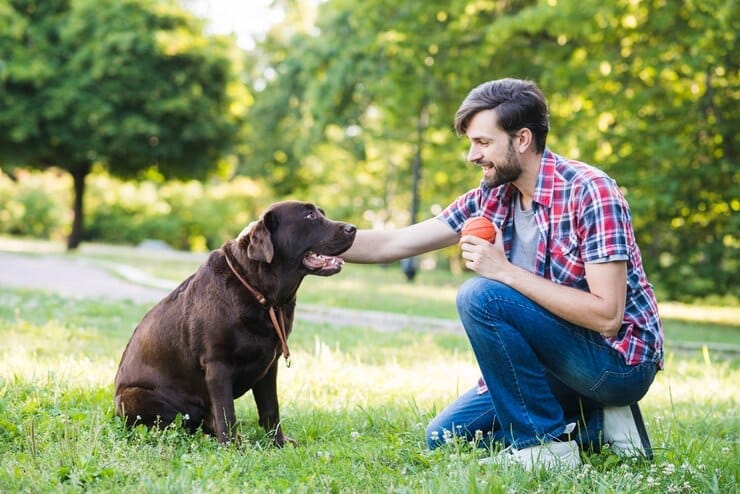Dog calming treats were created to offer some relief to both anxious canines and concerned pet owners. Just like us, our beloved pups can suffer from attacks of anxiety, which can produce symptoms that are distressing for them and uncomfortable for us.
They’re so in-tune to our emotions, that they can sense the anxiety we feel and mirror that behavior; if there’s a sudden change in the household, it can affect them directly. Of course, our pups can get stressed and anxious for many reasons, including loud noises from other darks, fireworks, or thunderstorms, among other triggers.
Perhaps you’ve already tried calming treats, or maybe you’re looking for more information, such as whether dog calming treats have side effects or are safe for puppies.
Below, we’ll explore the key facts behind dog calming treats and their safety, and we’ll also cover the most common signs of anxiety in dogs so that you know what to watch out for.

What Are Dog Calming Treats?
Dog calming treats, also known by the name nutraceuticals, provide much-needed relief from anxiety. There are several different kinds of dog calming treats that use different substances to help calm your pup down.
Some calming treats use a similar mechanism to human medications, incorporating melatonin or tryptophan, which have been shown to improve aggression and hyperactivity in canines. They may also use natural ingredients such as milk proteins.
Others utilize probiotics to improve gut health, which can help to offset some of those digestive problems that come with canine anxiety. These can be particularly useful in dogs that have developed diarrhea and reduced appetite as a result of stress and anxiety.
A newer innovation is dog calming treats with CBD. Much like the explosion of human-centric CBD calming products that have entered the market, these treats target the endocannabinoid receptors in dogs, which mirror the same function as our own. And as a hemp-based treat, they’re typically completely natural.
Here’s a quick rundown of some other ingredients used in dog calming treats:
- L-Theanine: This substance is used in some chewable tablets and can help to reduce anxiety.
- Lemon Balm: Lemon balm can induce greater levels of relaxation and encourage more docile behavior in pups. It’s often combined with other ingredients like L-Theanine.
- Valerian: Valerian is used by humans in tea to cam stress and anxiety. This plant is reportedly useful in dogs, though studies seem to be limited.
- Zylkene: A natural supplement to be used in advance of an event you know is going to be stressful for your pup.
Pheromones: A number of natural pheromone-based supplements can be used, many of which mimic the pheromones that your pup will remember from their childhood and parents.

Do Dog Calming Treats Have Side Effects?
Unfortunately, much like with our medications, dog calming treats can have side effects. These can potentially include:
- A drop in blood pressure
- Changes in toileting habits
- Heart rate irregularities
- Increased anxiety or stress
- Muscle twitching
- Tiredness
- Vomiting
- Weakness
It’s worth speaking to your trusted vet or animal health specialist to understand whether you should try dog calming treats with your pup. They’ll be able to advise you on the signs you should watch out for – and you can check the guidance provided by the manufacturer too.
Are dog calming treats safe for puppies?
Good-quality dog calming treats are generally safe for puppies. They can be used as a stress relief spot treatment, which is very useful in the early years of a new dog's life. Some pet parents might use dog calming treats for separation anxiety.

What Are the Alternatives to Dog Calming Treats?
If you’re on the fence about using dog calming supplements, the good news is that other methods have been seen to reduce anxiety in dogs too. You can try one or more of the following:
- Exercise: If you’ve been shirking the usual walk schedule, perhaps due to temperatures falling, this can induce anxiety and sadness in your pup. Be sure to get out with them regularly.
- Mental Workouts: It's not just about physical exercise; mental stimulation is also important for dogs that may be left alone for long periods during the day. Teaching your dog new tricks can also help to redirect their attention and distract them from potential stressors.
- Music: Studies have shown that music can help reduce anxiety levels in dogs, though the research also suggests that each dog can be different. So, experiment!
What Are the Signs of Anxiety in Dogs?
Like with any health concern, anxiety in dogs is not something that they can communicate with you. Instead, we have to pay attention to the subtle signs that might tell us something is amiss in our pet.
There can be some stigma around anxiety in humans, but it's a genuine condition that has physiological effects on the body. Well, the same can be said for dogs, which is why you should pay attention to your pup’s behavior and watch out for these common signs of anxiety in dogs:
- Aggression
- Diarrhea
- Excessive yawning
- Hiding themselves away
- Increased barking
- Increased destructive behavior
- Reduced appetite
- Shaking
- Urination at home, in a house-trained dog
Of course, just like with humans, symptoms can often be associated with a range of different conditions. It’s important to understand whether your dog is experiencing anxiety or another condition that requires specific treatment.
If you’re in any doubt, we recommend speaking to a trusted veterinarian for advice on how best to bring your pup back to good physical or mental health.

